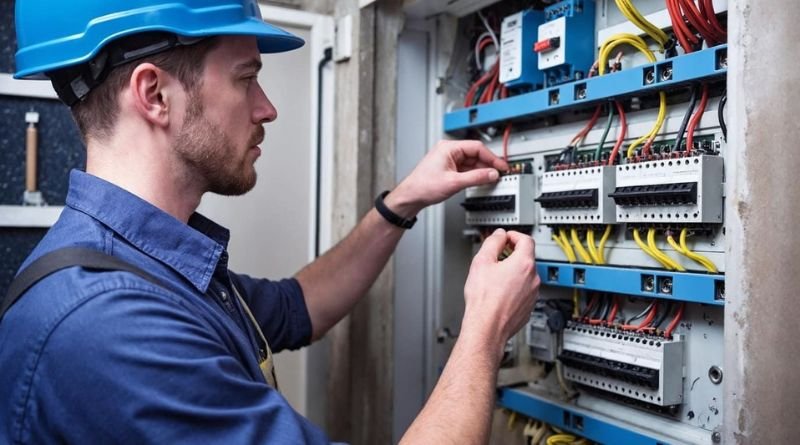Key Takeaways
- The cost of upgrading an electric panel varies based on capacity, labor, permits, and additional repairs.
- On average, homeowners can expect to pay between $1,200 and $2,000, though more complex projects may cost significantly more.
- The total budget should consider additional expenses such as surge protection, drywall repair, and breaker compliance.
- Choosing a licensed professional is crucial for safety, legal compliance, and long-term system reliability.
Table of Contents
- Understanding the Basics of Electrical Panel Upgrades
- Average Costs of Electrical Panel Upgrades
- Factors Influencing the Cost
- Additional Expenses to Consider
- Choosing the Right Electrical Contractor
- When to Consider an Upgrade
- Final Thoughts
Understanding the Basics of Electrical Panel Upgrades
Upgrading your home’s electrical panel is essential for maintaining safety and ensuring your electrical system meets the demands of modern appliances and technology. Many older panels were not designed to accommodate today’s higher household energy consumption, making upgrades not just a matter of convenience, but also of compliance and safety.
It’s important to work with a qualified local professional to ensure a reliable and code-compliant installation. For example, those seeking Matthews, NC electric panel upgrades by licensed electricians can trust trained experts to evaluate, plan, and install a panel suited to their precise needs.
Electrical panel upgrades improve the overall capacity of your home’s system, reducing risks of tripped breakers, electrical fires, and potential appliance damage. If you frequently notice flickering lights or experience sudden power interruptions, your existing panel may not be sufficient.
The cost of an upgrade depends on multiple elements, including the panel size, labor requirements, the condition of existing wiring, and necessary permits. Homeowners should anticipate some project complexity, especially in older homes where hidden issues are common.

Average Costs of Electrical Panel Upgrades
For most homeowners, a standard electrical panel upgrade typically costs between $1,200 and $2,000. This all-inclusive range covers the new panel, required labor, and permitting. However, installation costs may increase depending on your location, the condition and accessibility of your electrical system, and whether additional upgrades are necessary. Larger capacity panels or homes with more extensive wiring needs tend to be at the higher end of the range.
If you’re planning an upgrade, it’s wise to consult with at least two or three contractors to compare detailed cost estimates and project scopes. According to experts at Angi, labor and materials represent the bulk of the expense, but unexpected costs can arise, especially during inspections and final code compliance checks.
Factors Influencing the Cost
- Panel Capacity: Upgrading to a 100-amp panel can cost $800–$1,500. A 200-amp panel generally costs $1,300–$2,000, while 400-amp panels can reach $2,000–$4,000 or more.
- Labor Costs: Licensed electricians typically charge $50–$100 per hour. Basic installations require 4–8 hours; complex upgrades can require twice as much labor, especially in larger or older homes.
- Permits and Inspections: Most municipalities require permits, costing $50–$300, along with inspections, which may extend your timeline by one to two weeks.
- Wiring or Circuit Replacements:Homes with outdated or unsafe wiring may need additional replacements, which can add $500–$1,500 to your final bill.
Factors such as accessibility, regional pricing variations, and the need for specialty equipment or coordination with your utility provider also influence the bottom line.
Additional Expenses to Consider
Apart from the primary costs associated with the panel upgrade, homeowners often face several auxiliary expenses. These are important to account for to avoid budget overruns:
- Surge Protection Devices: Installing whole-home surge protection adds $250–$700 to total costs but can protect sensitive electronics and appliances from voltage spikes.
- Drywall Repair and Painting: Electrical panel replacements frequently involve cutting into walls, which might necessitate $200–$600 in repairs and repainting.
- GFCI/AFCI Circuit Compliance:Ensuring that your system meets updated code can require new ground-fault (GFCI) or arc-fault (AFCI) circuit breakers, which cost an additional $50–$150 per breaker.
Additional costs may arise if service upgrades are required outside the home or if unforeseen issues—such as pest infestations in wall cavities—are discovered during the project. Before starting the job, consult your electrician about the likelihood of these added expenses.
Choosing the Right Electrical Contractor
When upgrading your panel, it is essential to select a skilled, licensed, and insured electrical contractor. Confirm that your chosen professional holds valid state and local credentials, is in good standing, and provides clear proof of liability insurance. Reputable contractors ensure code-compliant installations, manage the required permits, and coordinate with utility companies as needed. Seek detailed written quotes and verify references from previous clients where possible.
When to Consider an Upgrade
Not all electrical panel upgrades are driven by immediate system failures. Typical signs that an upgrade is necessary include frequent breaker trips, flickering lights, or repeated blown fuses. Homes undergoing major remodels or adding high-demand appliances such as HVAC systems, hot tubs, or EV charging stations are prime candidates for a panel upgrade. Proactive upgrades help prevent fire hazards and future inconveniences, aligning your property with current safety standards and future-proofing against increased electrical needs.
Final Thoughts
Upgrading an electrical panel is a smart investment in ensuring the safety, efficiency, and reliability of your home’s electrical system. By understanding common costs, the various factors that influence them, and the necessity of employing skilled, licensed professionals, you can make informed decisions that protect your property and enhance its value. Plan for primary and incidental costs, and always prioritize quality workmanship and code compliance for long-term peace of mind.
